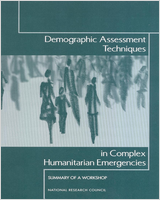NCBI Bookshelf. A service of the National Library of Medicine, National Institutes of Health.
National Research Council (US) Roundtable on the Demography of Forced Migration. Demographic Assessment Techniques in Complex Humanitarian Emergencies: Summary of a Workshop. Washington (DC): National Academies Press (US); 2002.

Demographic Assessment Techniques in Complex Humanitarian Emergencies: Summary of a Workshop.
Show detailsThe term complex humanitarian emergency refers to a situation in which a civilian population is displaced from their homes by war or conflict. In addition, there is often a deterioration of living conditions and sometimes a significant increase in mortality, either in the short or long term.1
One of the primary and earliest challenges in a complex humanitarian emergency is to obtain accurate estimates of displaced populations and their mortality rates. Although many basic guidelines exist to help field personnel in demographic assessment techniques, the quickly changing and generally unstable context of a crisis can make it difficult to implement a rapid assessment. The differing causes and demographic effects of emergencies— refugees or internally displaced persons,2 rapid onset or slow build-up, and mortality caused primarily by disease or mortality primarily due to human rights abuses—make a one-size-fits-all approach problematic. In addition, field staff may not be knowledgeable about the latest innovations in demographic techniques, which are continually being updated and improved.
The Roundtable on the Demography of Forced Migration under the aegis of the Committee on Population of the National Research Council held a workshop to examine some of these topics. This report to the roundtable summarizes the presentations and discussion, but does not make any attempt to provide guidelines, conclusions, or recommendations for researchers or policy makers.3 The report generally follows the order of the presentations and discussion listed in the workshop agenda (see the appendices).
Footnotes
1 This definition of complex humanitarian emergency is adapted from Keely et al. 2001.
2 Refugees are persons displaced from one country into another, while internally displaced persons (IDPs) are displaced within their own country.
3 This report is technical in nature and due to space constraints, many technical concepts are not fully explained. Some key terms and ideas are briefly defined—mainly in endnotes—and references are provided in some cases, but for more detailed information about sampling methodology, the reader should refer to key texts, such as Kish 1965 and Henry 1990.
- INTRODUCTION - Demographic Assessment Techniques in Complex Humanitarian Emergen...INTRODUCTION - Demographic Assessment Techniques in Complex Humanitarian Emergencies
- PREDICTED: Mus musculus ubiquitin conjugating enzyme E2 Q2 like (Ube2q2l), trans...PREDICTED: Mus musculus ubiquitin conjugating enzyme E2 Q2 like (Ube2q2l), transcript variant X4, mRNAgi|1907169521|ref|XM_006505223.5|Nucleotide
- kleisin beta (731)PMC
- SAMN25560368 (1)SRA
- breast cancer type 1 susceptibility protein isoform 109 [Homo sapiens]breast cancer type 1 susceptibility protein isoform 109 [Homo sapiens]gi|2255444265|ref|NP_001395360.1|Protein
Your browsing activity is empty.
Activity recording is turned off.
See more...